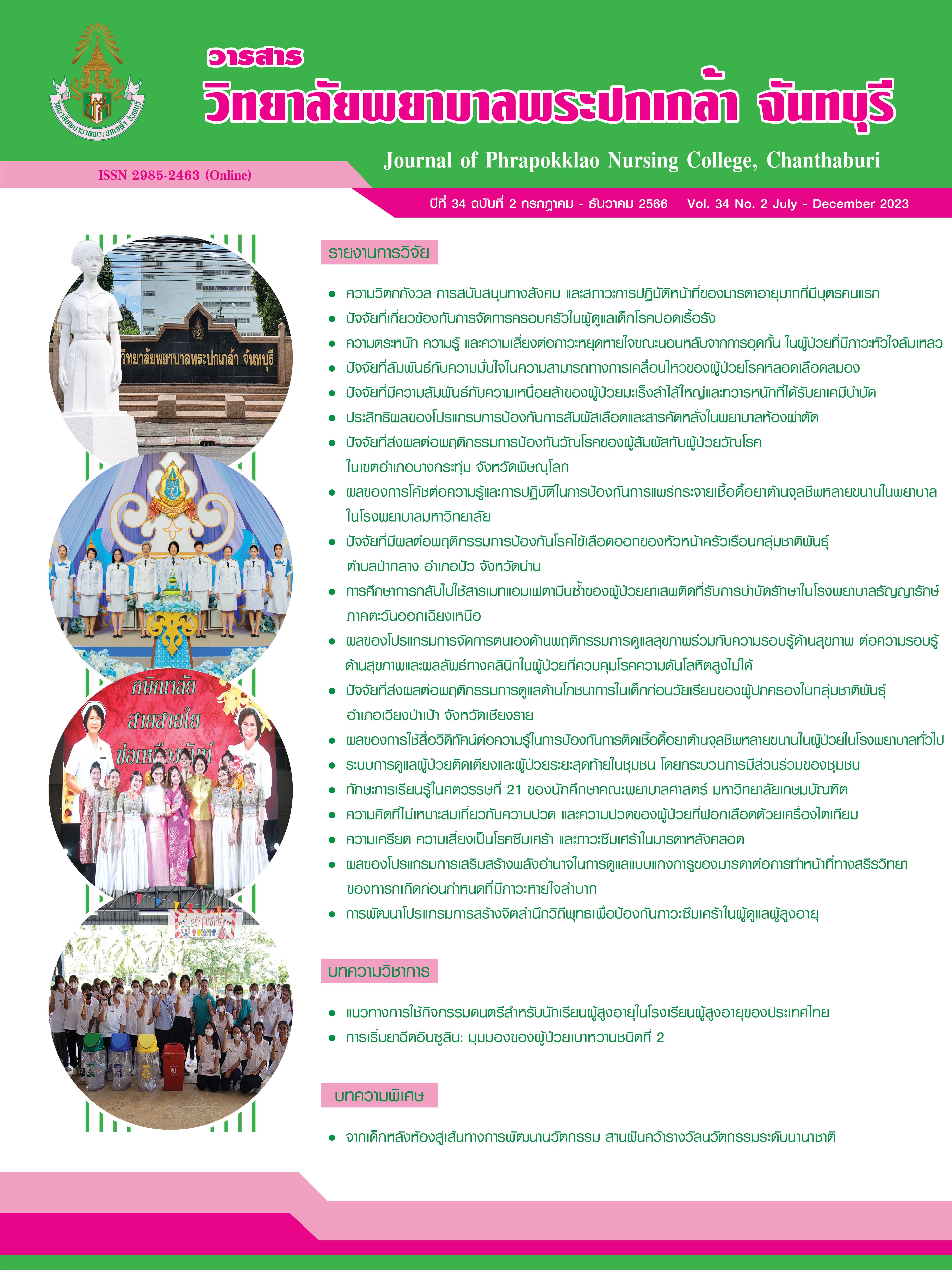Community Participatory Care System for Bedridden and End-of-life Patients in Community
Keywords:
Bedridden patients, End-of-life patients, Community participationAbstract
This participatory action research aimed to establish and assess the effectiveness of a community participatory care system for bedridden and end-of-life patients. The study, conducted in the community under the purview of Nong Phalan Sub-district Health Promoting Hospital’s responsibility, Mueang Nakhon Ratchasima District, Nakhon Ratchasima Province, Thailand, engaged 55 key informants, including health providers, community leaders, municipality officers, patient’s caregivers and relatives, village health volunteers, and Buddhist monks, along with 216 community members. The research instruments consisted of 1) three discussion interview guides; 2) an evaluation form of medical device management; 3) an evaluation form of patients care; 4) a focus-group interview guide; 5) a questionnaire assessing knowledge with a reliability of .73; 6) a questionnaire assessing competency perception with a reliability of .95; 7) an evaluation form of the benefits perception with a reliability of .96; and 8) an evaluation form of satisfaction with a reliability of .91. The research unfolded across four phases from March to September 2023: analysis of the current situation, development of the care system, implementation, and system evaluation. The statistical analysis used in this study encompassed mean, standard deviation, and Wilcoxon signed-rank test. Additionally, a content analysis was conducted to scrutinize and interpret the qualitative data.
The research results revealed that the existing care system for bedridden and end-of-life patients in community had inadequate management. The development of a community participatory care system centered around six critical aspects, consisting of 1) the establishment of a collaborative network; 2) securing financial support from governmental and private sectors; 3) preparing essential medical supplies; 4) creating a dedicated office for bedridden and palliative care; 5) enhancing caregiver competencies; and 6) implementing home visits by health providers, village health volunteers, and community leaders. Following a three-month implementation of the developed care system involving six bedridden patients and two end-of-life patients, noteworthy improvements in health conditions were observed for two bedridden patients, while the conditions of the remaining patients remained stable. Furthermore, two end-of-life patients experienced peaceful passings at home. Participants’ perceptions of the system’s benefits and satisfaction were very high (M = 46.32, SD = 3.87 and M = 32.14, SD = 2.46, respectively). Moreover, community members expressed a high perception of the system’s benefits (M = 43.22, SD = 5.88) and a strong perceived need for its continuation (M = 4.50, SD = .46).
This research strongly recommends the adoption and adaptation of the developed community participatory care system in other communities and primary care units, emphasizing the importance of tailoring the care system to specific community contexts.
References
กรมกิจการผู้สูงอายุ. (2566). สถิติผู้สูงอายุ มิถุนายน 2566 by Looker Studio. สืบค้นจาก https://www.dop.go.th/th/know/side/1/1/2449
กองการพยาบาลสาธารณสุข. (2559). มาตรฐานการดูแลผู้ป่วยและผู้สูงอายุที่ต้องได้รับการดูแลต่อเนื่องที่บ้าน. สืบค้นจาก https://phn.bangkok.go.th/images/CareGiver/CG2565/51.pdf
กัญญ์สิริ จันทร์เจริญ. (2552). การกำหนดประชากรและกลุ่มตัวอย่าง. ใน ประกาย จิโรจน์กุล (บ.ก.), การวิจัยทางการพยาบาล: แนวคิด หลักการ และวิธีปฏิบัติ (น. 85–114). นนทบุรี: โครงการสวัสดิการวิชาการ สถาบันพระบรมราชชนก.
กาญจนา ปัญญาธร, กฤษณา ทรัพย์สิริโสภา, กมลทิพย์ ตั้งหลักมั่นคง, และวรรธนี ครองยุติ. (2564). การมีส่วนร่วมของชุมชนในการป้องกันโรค COVID-19 บ้านหนองสวรรค์ ตำบลเชียงพิณ อำเภอเมือง จังหวัดอุดรธานี. วารสารวิทยาลัยพยาบาลพระปกเกล้า จันทบุรี, 32(1), 189–204.
ทวีศักดิ์ กสิผล, และภัทรา เล็กวิจิตรธาดา. (2554). หลักการพยาบาลอนามัยชุมชน. ใน จริยาวัตร คมพยัคฆ์ และวนิดา ดุรงค์ฤทธิชัย (บ.ก.), การพยาบาลอนามัยชุมชน แนวคิด หลักการ และการปฏิบัติการพยาบาล (น. 151–177). กรุงเทพฯ: จุดทอง.
บำรุง วงษ์นิ่ม. (2565). การพัฒนาสมรรถนะด้านการสื่อสารสุขภาพของอาสาสมัครสาธารณสุขประจำหมู่บ้าน ด้วยกระบวนการมีส่วนร่วมของเครือข่ายสุขภาพอำเภอท่าวุ้ง. วารสารโรงพยาบาลสิงห์บุรี, 31(2), 54–67.
พรทวี ยอดมงคล. (2556). คู่มือสำหรับประชาชน การดูแลผู้ป่วยระยะสุดท้ายแบบประคับประคอง (Palliative care). สมุทรสาคร: พิมพ์ดี.
พรฤดี นิธิรัตน์, และสายใจ จารุจิตร. (2559). กระบวนการพยาบาลกับการดูแลสุขภาพชุมชน. กรุงเทพฯ: ธนาเพรส.
พระครูสุวิธานพัฒนบัณฑิต, ธวัลรัตน์ แดงหาญ, และสรัญญา วภัชชวิธี. (2558). การพัฒนารูปแบบการดูแลสุขภาพองค์รวมของพระสงฆ์ในจังหวัดขอนแก่น โดยเน้นการมีส่วนร่วมของเครือข่าย. วารสารสำนักงานป้องกันควบคุมโรคที่ 6 ขอนแก่น, 22(2), 117–130.
มานพ ผสม. (2566). พัฒนารูปแบบการดูแลผู้ป่วยเบาหวานที่ควบคุมโรคไม่ได้ ในคลินิกเบาหวาน โรงพยาบาลส่งเสริมสุขภาพตำบลหนองพะลาน ตำบลหนองระเวียง แบบบูรณาการมีส่วนร่วมของชุมชน. วารสารสุขภาพและสิ่งแวดล้อมศึกษา, 8(3), 20–30.
มูลนิธิสถาบันวิจัยและพัฒนาผู้สูงอายุไทย. (2565). รายงานสถานการณ์ผู้สูงอายุไทย พ.ศ. 2564. สืบค้นจาก https://thaitgri.org/?p=40101
รัตน์ศิริ ทาโต. (2566). การวิจัยทางพยาบาลศาสตร์ : แนวคิดสู่การประยุกต์ใช้ (ฉบับปรับปรุง) (พิมพ์ครั้งที่ 7). กรุงเทพฯ: สำนักพิมพ์จุฬาลงกรณ์มหาวิทยาลัย.
วรัญญา จิตรบรรทัด, และมิ่งขวัญ เกตุกำพล. (2565). ผลการพัฒนารูปแบบการดูแลผู้ป่วยระยะท้ายในชุมชน. วารสารมหาจุฬานาครทรรศน์, 9(12), 155–170.
วิโรจน์ ไววานิชกิจ. (บ.ก.). (2563). หลักการพยาบาลผู้สูงอายุ เล่ม 8 หลักการดูแลผู้สูงอายุในชุมชนและที่บ้าน การดูแลผู้ป่วยติดบ้านและผู้ป่วยติดเตียง. กรุงเทพฯ: โรงพิมพ์แห่งจุฬาลงกรณ์มหาวิทยาลัย.
สายพิณ เกษมกิจวัฒนา, และปิยะภรณ์ ไพรสนธิ์. (2557). ญาติผู้ดูแลผู้ป่วยเรื้อรัง: กลุ่มเสี่ยงที่ไม่ควรมองข้าม. วารสารสภาการพยาบาล, 29(4), 22–31.
สำนักวิจัยและพัฒนาระบบงานบุคคล. (2561). ภาครัฐกับการเตรียมความพร้อมเข้าสู่สังคมสูงวัย. สืบค้นจาก https://www.ocsc.go.th/sites/default/files/document/ocsc-2561-y60b04.pdf
สุมิตรา วิชา, ณัชพันธ์ มานพ, สุภา ศรีรุ่งเรือง, เบญจพร เสาวภา, ศิริรัตน์ ศรีภัทรางกูร, ณัฐกานต์ ตาบุตรวงศ์, ... ธนัชพร มณีวรรณ. (2561). การพัฒนาระบบเครือข่ายบริการสุขภาพสำหรับผู้สูงอายุกลุ่มติดบ้านและกลุ่มติดเตียง (กรณีศึกษาผู้สูงอายุกลุ่มติดบ้าน และกลุ่มติดเตียงในเขตรับผิดชอบของ รพ.สต.ฮ่องห้า อ.แม่ทะ จ.ลำปาง). สืบค้นจาก https://kb.hsri.or.th/dspace/handle/11228/4827
อัมพรพรรณ ธีรานุตร, นงลักษณ์ เมธากาญจนศักดิ์, วาสนา รวยสูงเนิน, และดลวิวัฒน์ แสนโสม. (2553). คู่มือการดูแลผู้ป่วยเรื้อรังที่บ้าน (พิมพ์ครั้งที่ 3). ขอนแก่น: โรงพิมพ์คลังนานาวิทยา.
Arnstein, S. R. (1969). A ladder of citizen participation. Journal of the American Institute of Planners, 35(4), 216–224. doi:10.1080/01944366908977225
Miles, M. B., & Huberman, A. M. (1994). Qualitative data analysis: An expanded sourcebook (2nd ed.). Thousand Oaks: SAGE Publications.
Thai PBS. (2563). ประชากรที่ป่วยในประเทศไทย. สืบค้นจาก https://twitter.com/ThaiPBS/status/1309697244023549953
Downloads
Published
How to Cite
Issue
Section
Categories
License
Copyright (c) 2023 Journal of Phrapokklao Nursing College, Chanthaburi

This work is licensed under a Creative Commons Attribution-NonCommercial-NoDerivatives 4.0 International License.
เนื้อความ ข้อมูล และรายการอ้างอิงที่ผู้เขียนใช้ในการเขียนบทความเพื่อลงตีพิมพ์ในวารสารวิทยาลัยพยาบาลพระปกเกล้า จันทบุรี ถือเป็นความคิดเห็นและความรับผิดชอบของผู้เขียน คณะผู้จัดทำวารสารไม่จำเป็นต้องเห็นพ้องด้วยหรือร่วมรับผิดชอบ
บทความที่ได้รับการลงตีพิมพ์ในวารสารวิทยาลัยพยาบาลพระปกเกล้า จันทบุรี ถือเป็นลิขสิทธิ์ของวารสารวิทยาลัยพยาบาลพระปกเกล้า จันทบุรี หากหน่วยงานหรือบุคคลใดต้องการนำส่วนหนึ่งหรือทั้งหมดของบทความไปเผยแพร่ต่อเพื่อวัตถุประสงค์ใด ๆ จะต้องได้รับอนุญาตจากบรรณาธิการวารสารก่อน



